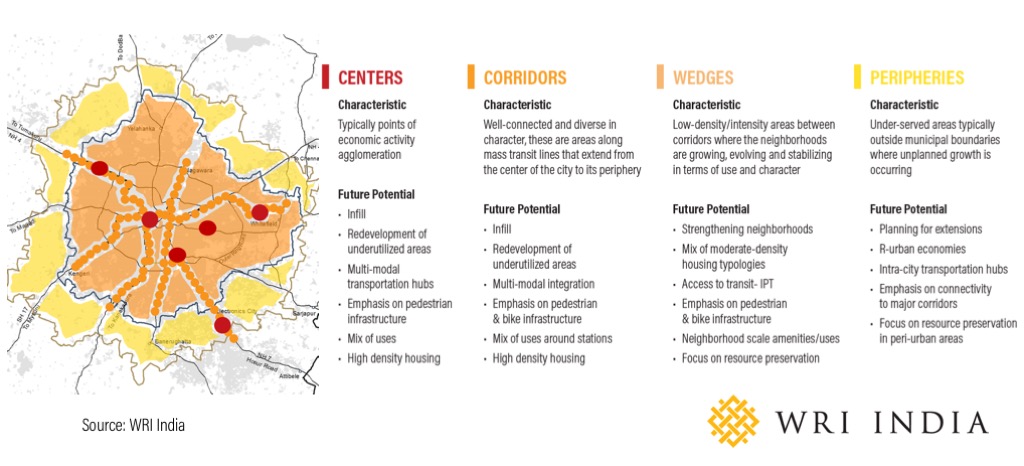Unlock Bengaluru: Driving the Next Wave of Urbanisation
by and -
From Bangalore to Bengaluru
In 1970, Bangalore had 1.6m people. Within the decade, the emergence and expansion of public sector institutions such as the Indian Space Research Organisation, Bharat Electrical Limited, and Hindustan Machine Tools caused a sudden growth spurt, followed quickly by more growth owing to the textile and information technology industries gaining a foothold in the city. By the 1980s, the population was growing at the rate of 45 percent, and today, over 11 million people call Bangalore home. Along with increasing population, the city limits were increased from 70 sq km in 1941 to 710 sq km in 2011, and the name was changed from Bangalore to Bengaluru in 2014. Since then, Bengaluru has emerged as the most vibrant city in the country, attracting a major share of Foreign Direct Investment and becoming the fourth largest technology cluster in the world. According to Jones Lang Lasalle’s 2017 City Momentum Index, Bengaluru has been ranked as the most dynamic city in the world.
Driving Urbanisation
Economic reforms and growing employment opportunities in Bengaluru continue to accelerate the pace of urbanisation. The city today adds about 500 families and 80,000 sq. mts. of built up area per day within its limits, with this trend expected to continue well over to the next decade. Currently, the average Bengaluru citizen consumes 1406 kwh per annum of electricity, 80 sq. mtrs. in land and requires about 135 LPCD water per day. Further, around 2.2 million people or 25 percent of the population within the city limits do not have access to piped water supply, and the road networks are woefully inadequate. At this rate of consumption, we will need roughly 1500 sq. kms or an additional two more Bengaluru cities to accommodate the population projected over the next decade and about two Raichur thermal power plants to meet the electricity requirements.
India currently has 30 percent urban population and 10 percent urban representation in parliament. Encumbered by lengthy and time-consuming processes with undefined goals and budgets, along with lack of capacity, urban local bodies struggle to meet the ever-rising developmental demands that cities place on them. For instance, Bengaluru has only less than 100 government town planners catering to a city of 11 million people despite development occurring at the rate of 600 sq ft per minute.
The Emerging City Morphology – Centres, Corridors, Wedges and Peripheries
Large scale projects such as the Bengaluru International Airport, IT parks, and the metro rail continue to reshape and resize the city’s landscape. Bengaluru can be spatially categorised in four geographic types: high intensity economic activity centres; mass transit corridors which connect people to jobs; wedges containing neighbourhoods; and fast growing peripheries.
The diagram below shows that these categories have distinct characterises and associated potential in the larger framing of the city. This provides a vision for the overall development of the city and can help formulate policies to organise and guide growth into areas that can support new development or are in need of redevelopment and away from areas that cannot support it. In this place-based approach, while the centres and corridors should be areas of targeted high-intensity development, the wedges provide the opportunity for improving efficiencies and preservation of resources such as water-bodies and natural areas. Peripheries, which are mostly unplanned, can leverage the benefits of a distributed system, thereby reducing costs of service provisioning.

Ensuring a resource-secure future will require investments in solutions that look at reduction in consumption patterns, behavioural changes, focus on renewable sources and adapting legal frameworks for management, at the same time providing equitable access. Moreover, getting to compact, connected, coordinated and equitable growth which will help realise efficiencies in city systems will require a focused approach. Enabling dense networks which complement growth in corridors, planned and well-serviced peripheries and stabilising neighbourhoods in transition with optimally cost differentiated services, so that infrastructure networks can be capacitated and aligned to growth requirements, will be key.
With a multiplicity of organisations and overlapping responsibilities, often resulting in disjointed planning, a clearly articulated process is needed to ensure service delivery demands. Increasing meaningful stakeholder participation in planning and budgeting for the city, with transparency, accountability, and capacity building will improve effectiveness and efficiency in governance systems. Given the socio-political challenges, coupled with the pressures of a growing economy and recognizing that structural changes in governance will not be immediate, city agencies need to partner to push for disruptive changes and multi-sectoral solutions. This perspective of the spatial organization of the city can direct strategic planning efforts aimed at resource and infrastructure planning, investment allocation as well as coordinated governance and service delivery in a meaningful manner. Ultimately, this approach provides the opportunity to create differentiated service levels benchmarks for each area so as to unlock Bengaluru and nudge it back onto the trajectory of sustainable urban growth.


